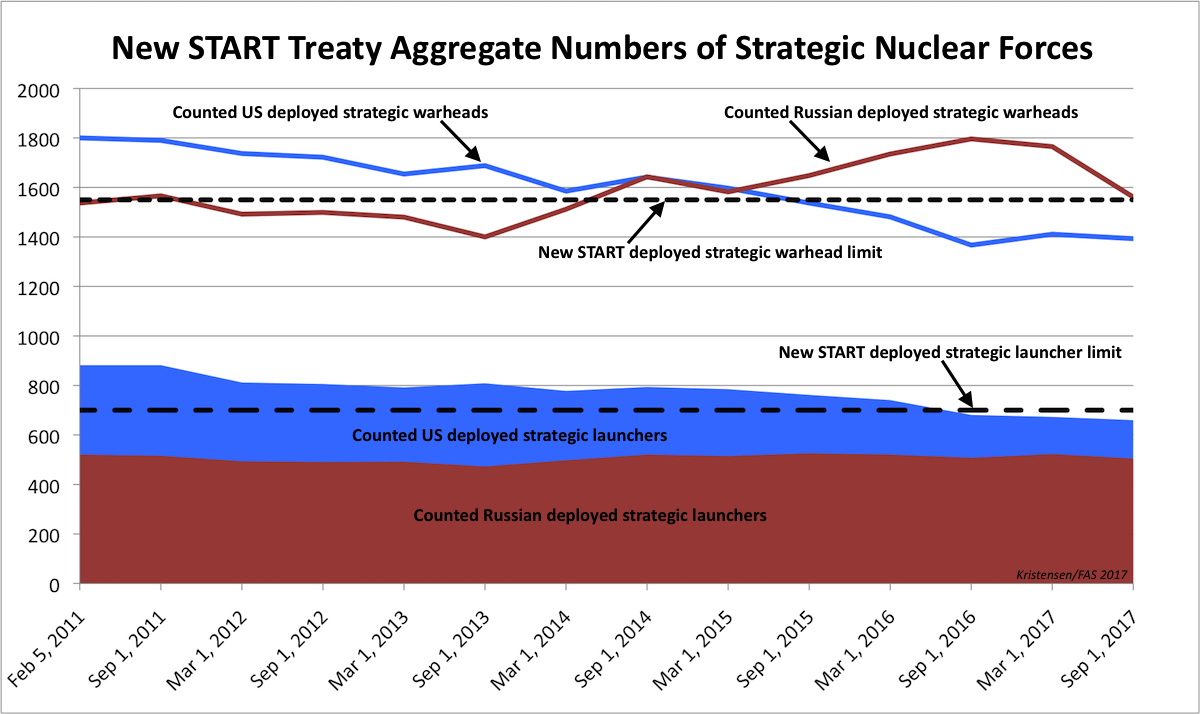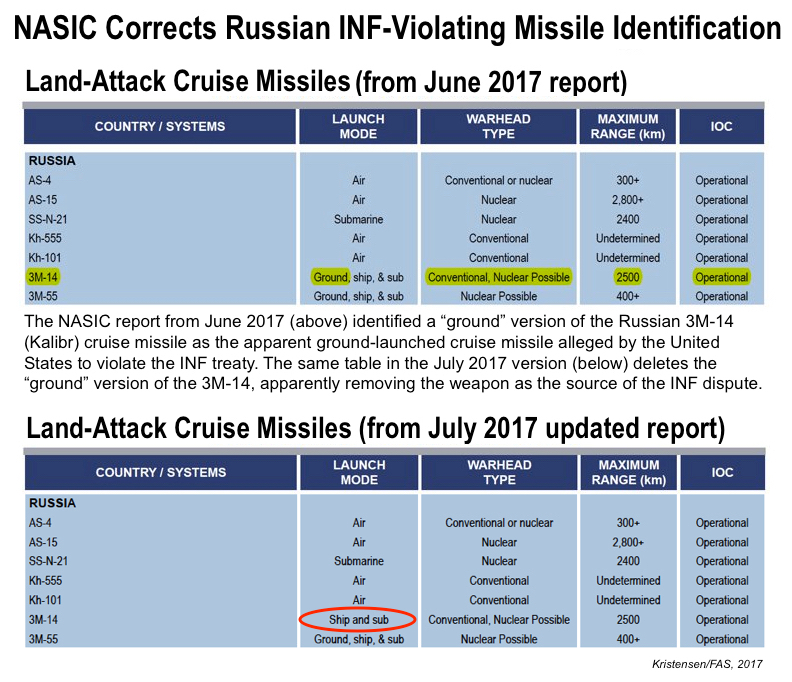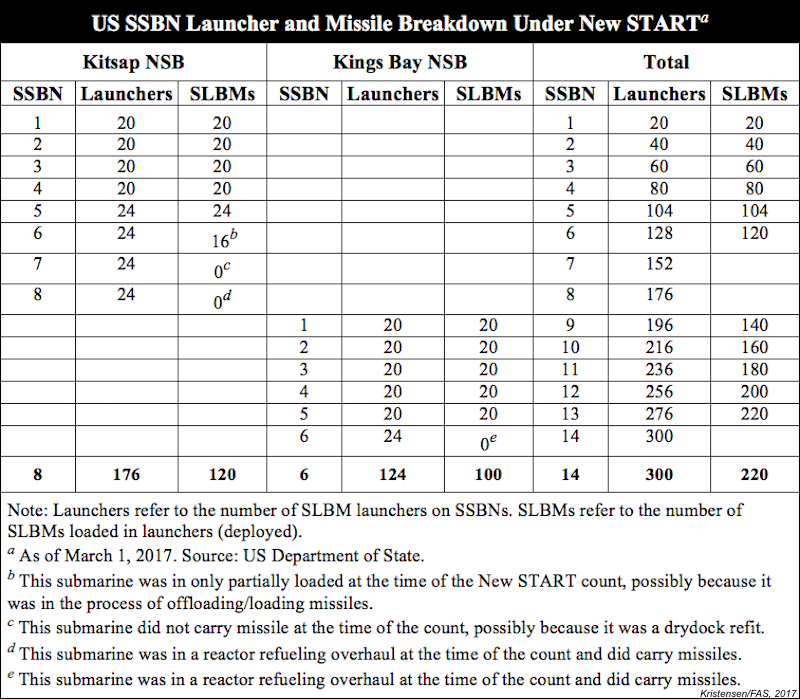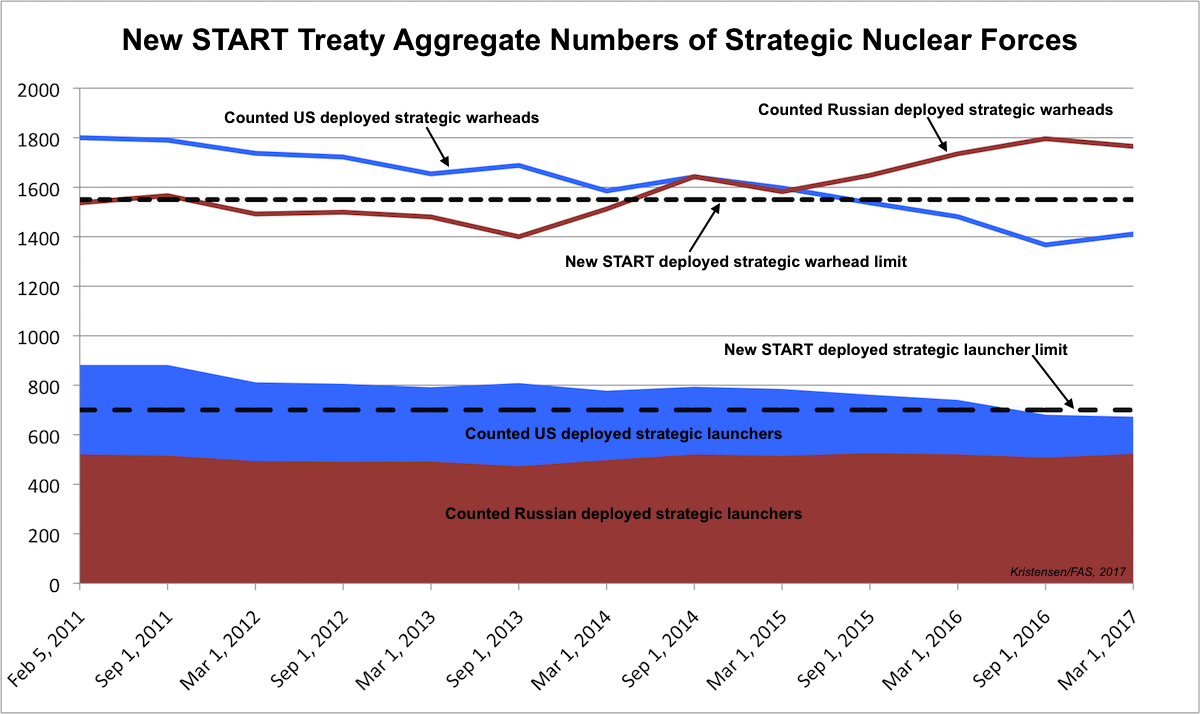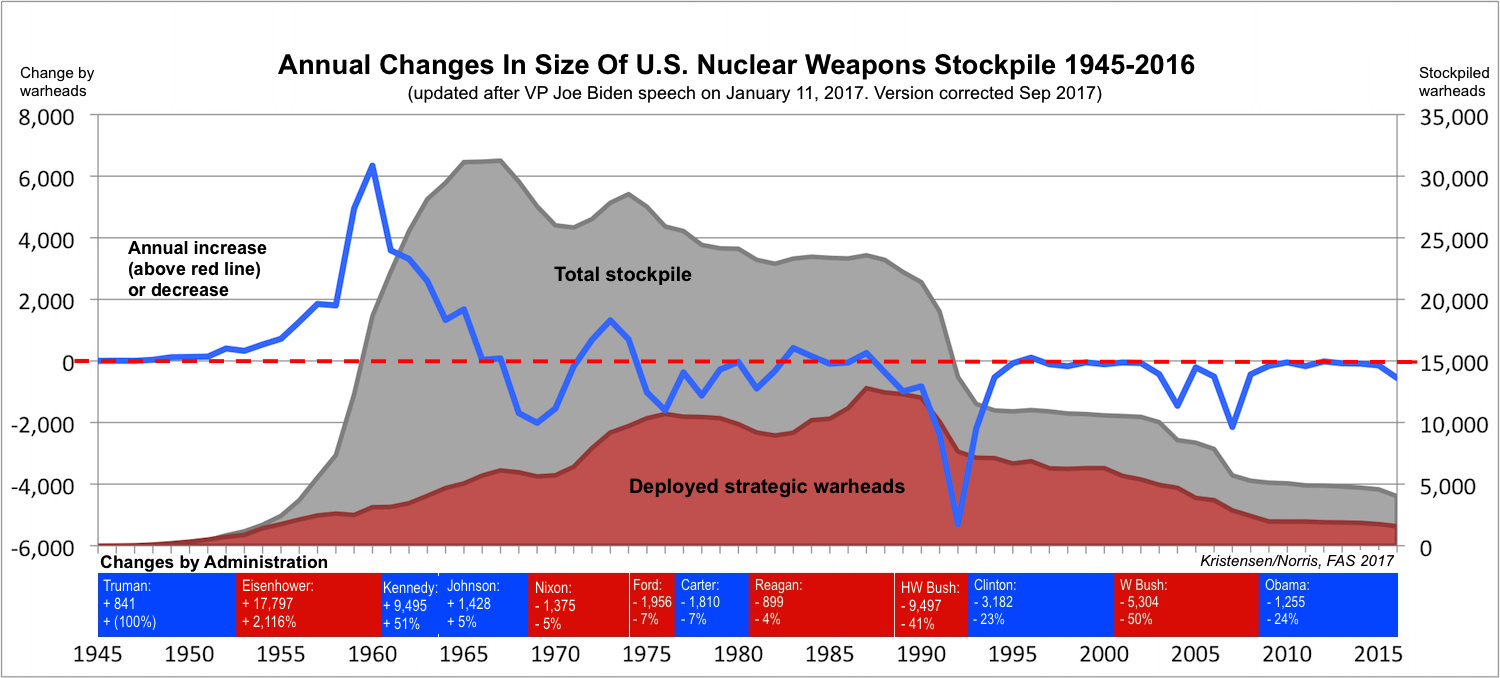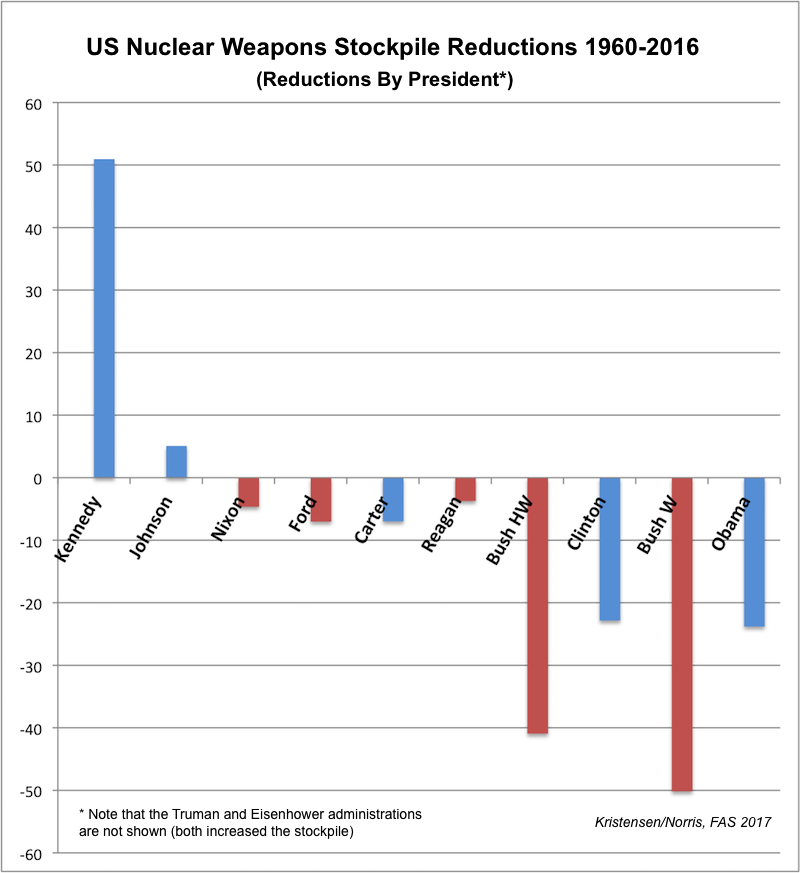New START Data: Russia Slashes Deployed Warheads, US Reaches Limits
By Hans M. Kristensen
The United States has now reached the limits for all three weapons categories under the New START treaty.
The latest data published by the State Department shows that the United States for the first time since the treaty entered into force in 2011 has reached the limit of 800 deployed and non-deployed strategic launchers. The 660 deployed launchers are also below the treaty limit of 700 and the 1,393 deployed warheads is well below the limit of 1,550. As such, the United States is now technically in compliance with the treaty.
The latest US reductions are the result of denuclearization of bombers and reduction of launch tubes on the Ohio-class submarines.
The data shows that Russia has reduced its deployed strategic warheads by 235 in the past 12 months and is now only 11 warheads above the New START treaty limit of 1,550 warheads to be achieved by February 2018. Russia is already below the treaty limit on deployed launchers as well as deployed and non-deployed launchers.
Russia’s increase in deployed strategic warheads between 2013 and 2016 triggered widespread claims by defense hawks that Kremlin was building up its nuclear forces. As I previously pointed out, that was wrong and the result of temporary fluctuations in the Russian force structure. Russia is modernizing, not increasing, its nuclear arsenal.
The Bigger Picture
The latest data shows that the United States has a significant advantage over Russia in deployed strategic launchers; 660 versus 505. The 155-launcher disparity means Russia emphasizes multiple warhead loading on its ICBMs while the United States has downloaded its ICBMs to carrying only a single warhead each. A future follow-on treaty will need to address this disparity, which is unhealthy for long-term strategic stability.
Although the United States and Russia are now at, near, or below the limits of the New START treaty, the warheads counted by the treaty only constitute a small fraction of the two countries’ total warhead inventories.
We estimate that Russia has a military stockpile of 4,300 warheads with more retired warheads in reserve for a total inventory of 7,000 warheads. For its part, we estimate the United States has a military stockpile of 4,000 warheads with more retired warheads in reserve for a total inventory of 6,800 warheads.
These arsenals are vastly in excess of the nuclear force levels maintained by other nuclear-armed states and constitute more than 90% of the world’s combined inventory of nearly 15,000 nuclear warheads.
Moreover, the New START treaty does not limit the 2,350 non-strategic nuclear warheads we estimate that Russia and the United States have in their arsenals combined. Both sides are modernizing their non-strategic nuclear forces.
Finally, the New START treaty expires in 2021 unless extended for another five years. The Trump administration has previously indicated opposition to extending the treaty, although recent discussions with Russia may seek to change that. A follow-on treaty seems unlikely given the current political climate but could easily be achieved by reducing the excess nuclear forces of Russia and the United States.
This publication was made possible by a grant from the Carnegie Corporation of New York, the New Land Foundation, and the Ploughshares Fund. The statements made and views expressed are solely the responsibility of the author.
NASIC Removes Russian INF-Violating Missile From Report
By Hans M. Kristensen
The U.S. Air Force National Air and Space Intelligence Center (NASIC) has quietly published a corrected report on the world’s Ballistic and Cruise Missile Threats that deletes a previously identified Russian ground-launched cruise missile.
The earlier version, published on June 26, 2017, identified a “ground” version of the 3M-14 land-attack cruise missile that appeared to identify the ground-launched cruise missile the United States has accused Russia of testing and deploying in violation of the 1987 INF Treaty.
The corrected version, available on the NASIC web site, no longer lists a “ground” version of the 3M-14 (popularly referred to as Kalibr) but only ship- and submarine-launched versions of the missile.
Apart from correcting the spelling of the North Korean Bukkeukseong-2 medium-range ballistic missile and downgrading the operational status of the Iranian Shahab-3 medium-range ballistic missile from deployed with “fewer than 50” launchers to “undetermined,” the deletion of the “ground” version of the Russian 3M-14 appears to be the only correction in the new NASIC report. (Curiously, the report still doesn’t identify the Russian Kh-102 air-launched cruise missile). Other than these changes buried deep in the report, however, there are no external markings on the new version to indicate that it has been changed (the URL identifies the new report date as July 21, 2017).
The older version of the NASIC report has been deleted from the NASIC web site, but a copy can be found here.
Implications and Recommendations
The deletion of the 3M-14 as the apparent INF-violating missile from the NASIC report is noteworthy, but it doesn’t actually change much. In essence, it returns the public INF debate to square one where it was three months ago. The correction even helps clear up confusion about the origins and status of the alleged Russian INF violation (several of us in the GNO community have been trying to crosscheck and cross-reference missile designations).
The United States has refused to publicly identify the INF-violating ground-launched cruise missile, apparently to protect intelligence sources. Instead, government sources have described what the missile is not (see here for previous statements). Although NASIC took the time to correct the error, it missed the opportunity to identify the actual INF-violating ground-launched cruise missile.
The correction refocuses the attention back on what I’ve heard all along: That the Russian INF-violating missile is thought to be a modification of the ground-launched SSC-7, a short-range cruise missile used on the Iskander system. But U.S. intelligence officials are adamant that the INF-violating missile is not the Iskander but a state-of-the-art missile. The new missile is known in the U.S. intelligence community as the SSC-8. The launcher itself apparently is physically different from the one used for the SSC-7. I co-authored a paper about this with the Deep Cuts Commission in April.
Apparently one battalion is operational and a second is fitting out, potentially embedded with Islander battalions starting in central Russia, and deployments are expected eventually in all four Russian military districts. So far, however, according to U.S. officials, the SSC-8 does not appear to give Russia any military advantage in Europe. And the U.S. military already has the military capability to counter the SSC-8 with sea- and air-launched cruise missiles and other means.
The U.S. refusal to identify the missile has given the Russian government the public space to “play ignorant” and claim it doesn’t know what the U.S. government is talking about. Similarly, the secrecy has made it difficult for allied governments to verify the claim and privately and publicly assist the United States with putting pressure on Russia to return to treaty compliance. That, in turn, has allowed hardliners in the U.S. Congress to propose that the United States should also develop it’s own ground-launched cruise missile (something the U.S. military does not believe is necessary).
Rather than making a bad situation worse, in order to sustain and increase pressure on Russia to return to INF compliance, the United States must reinforce its own commitment to the treaty by rejecting any Cold War proposal to mimic Russia’s bad behavior by developing a U.S. ground-launched cruise missile and instead focus potential military responses on existing forces already widely available, remove public ambiguity by identifying the Russia missile and disclose the information it has shared with Russia (if it can tell the Kremlin, then it can also tell the rest of the world), increase intelligence sharing with allies to improve their ability to work the issue with Russia directly, and pursue the matter directly with Russia in the Special Versification Commission of the INF treaty.
Background information:
- NASIC (corrected) report on Ballistic and Cruise Missile Threats
- NASIC (previous) report on Ballistic and Cruise Missile Threats
- FAS review of NASIC Report 2017: Nuclear Force Developments
- Deep Cuts Commission: Preserving the INF Treaty
This publication was made possible by a grant from the Carnegie Corporation of New York, the New Land Foundation, and the Ploughshares Fund. The statements made and views expressed are solely the responsibility of the author.
New START Data Shows US Implementation, Questions About Bomber Force
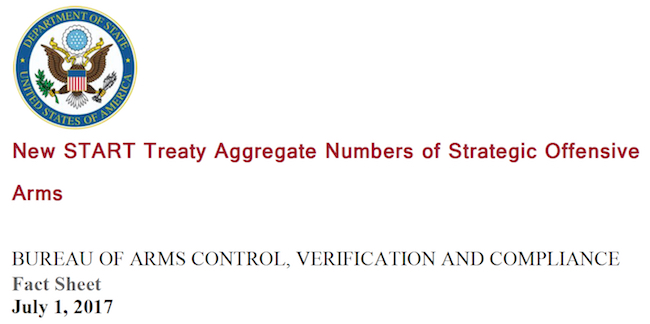
By Hans M. Kristensen
While defense hawks try to block funding for implementing the US-Russian New START treaty, the US military is making rapid process toward meeting the treaty limits by February 2018.
The latest full declassified aggregate data for the US force structure under New START shows that both the ICBMs and bombers appear to have reached the force level planned and more than two-thirds of the SSBN fleet has been converted as well.
But the implementation also raises questions about what the plan is for the future bomber force structure. Depending on how many new B-21 bombers the Air Force will deploy how soon and how many will be nuclear-capable, the Air Force might have to withdraw the B-52 from the nuclear mission by the early 2030s.
This also raises questions about the need to deploy the new nuclear air-launched cruise missile (RLSO) on the B-52 bombers. The new B-21 is intended to take over the nuclear air-launched cruise missile mission. The B-2 appears to have been eliminated as a future LRSO platform.
The ICBM Force
The Minuteman III ICBM force is listed with 405 deployed missiles, a reduction of 8 since September 2016. Since this count was reported, the Air Force has removed the last 5 ICBMs from their silos, leaving 400 deployed ICBMs, the goal identified in the New START Implementation report.
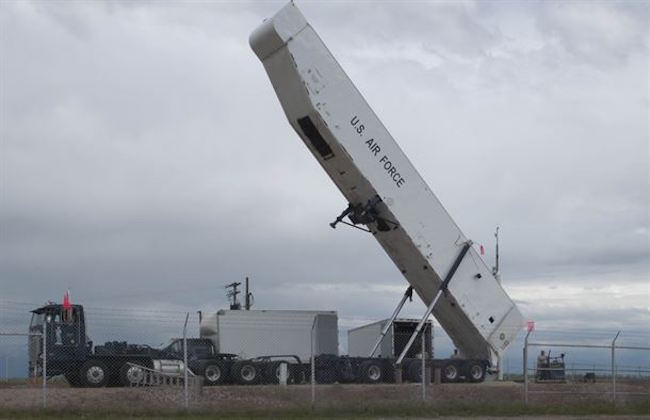
A Minuteman III ICBM is removed from its silo at Malmstrom AFB on June 2, 2017, as part of US implementation of the New START treaty.
The ICBM reduction is spread evenly across the three missile wings (133 ICBMs per wing), but other detailed New START data obtained from State Department shows that Malmstrom AFB was the first of the three wings to reach the 133 number.
Although the number of deployed ICBMs has been reduced, the total number of deployed and non-deployed ICBMs has not gone down but remains at 454 as in September 2016. The reason is that the reduction of 50 deployed ICBMs since 2011 requires the 50 empty silos to be kept “warm” and ready for redeployments if necessary. There is no strategic need to do so.
All deployed Minuteman III ICBMs have been “de-MIRVed” and currently carry one warhead each. Yet more than half of the force (those with the W78/Mk12A reentry vehicle) can still carry up to three warheads; the additional warheads are in storage. The remaining W87/Mk21-equipped ICBMs can only carry one warhead each. However, all of the next-generation ICBMs (currently known as Ground Based Strategic Deterrent, GBSD) will be MIRVable.
The SSBN Force
The New START data shows that US SSBNs carried a total of 220 SLBMs at the time of the count. That’s 11 missiles more than the previous count in September 2016. A total of 80 launchers were empty (three SSBNs in drydock and one in missile handling) for a total of 300 missile launch tubes.
Nine of the 14 SSBNs appear to have been converted to 20 missile launchers, a reduction of 4 missile launchers per boat to meet the New START overall limit of 700 deployed launchers. As of March 2017, the navy still had to inactivate a total of 20 launch tubes on five SSBNs to reach the goal of 280 deployed and non-deployed SLBM launchers by February 2018. Of those, no more than 240 will be deployed at any time.

The USS Alaska (SSBN-732) that returned to Kings Bay in mid-June following its 100th deterrent patrol since 1986, probably carried 20 Trident II SLBMs loaded with 88 nuclear W76-1 and W88 warheads.
Additional information obtained from State Department shows where the changes have been made (see table below). The Atlantic fleet has almost completed the conversion to 20 launchers per SSBN (one sub in refueling overhaul is probably being converted), while the Pacific fleet still has three SSBNs with 24 missiles, but two of them were empty at the time of the count (one of them in refueling overhaul) and a third was only partially loaded (probably undergoing missile handling).
The full declassified aggregate data also shows that there were a total of 958 warheads onboard deployed SLBMs as of March 2017, or nearly two-thirds of the total warhead number permitted by New START by February 2018. The United States does not need to make additional reductions in deployed warheads but could in fact increase the number of warheads deployed on SSBNs by another 139 warheads if it decided to do so.
The Heavy Bomber Force
The reduction of nuclear bombers appears to be complete. The Air Force has not yet declared so in public, but the data shows the number of deployed and non-deployed nuclear bombers are down to 66 – the same number required by the New START Implementation report. That is a reduction of 45 bombers compared with the inventory of 111 nuclear-capable bombers declared back in September 2011 (another 39 retired bombers were also declared as nuclear at the time but did not have an actual nuclear mission).

B-1, B-2 and B-52 bombers at RAF Fairfield in England on June 12, 2017. B-1 is equipped with conventional JASSM-ER. The B-2 and B-52 are nuclear-capable and part of the 66 nuclear bomber force planned under the New START treaty.
At 48, the number of deployed nuclear bombers is now 12 aircraft below the “up to 60 deployed heavy bombers” the Pentagon set in 2010 as the New START force level. That development is despite the B-52s having lost the nuclear gravity bomb mission and is now only delivering ALCMs; only the B-2 today has a strategic gravity bomb mission. The willingness to drop below the 60 indicates that there is excess capacity in the nuclear bomber force.
Moreover, with a New START force level of 66 deployed and non-deployed nuclear bombers (20 B-2s and 46 B-52s), an important question is how many of the new B-21 bombers will be nuclear-capable. The Air Force wants “a minimum of 100” B-21s in total and Lt Gen Jack Weinstein, the Air Force’s deputy chief of staff for strategic deterrence and nuclear integration, reportedly told Flight Global that the entire fleet of B-21s will be dual-capable.
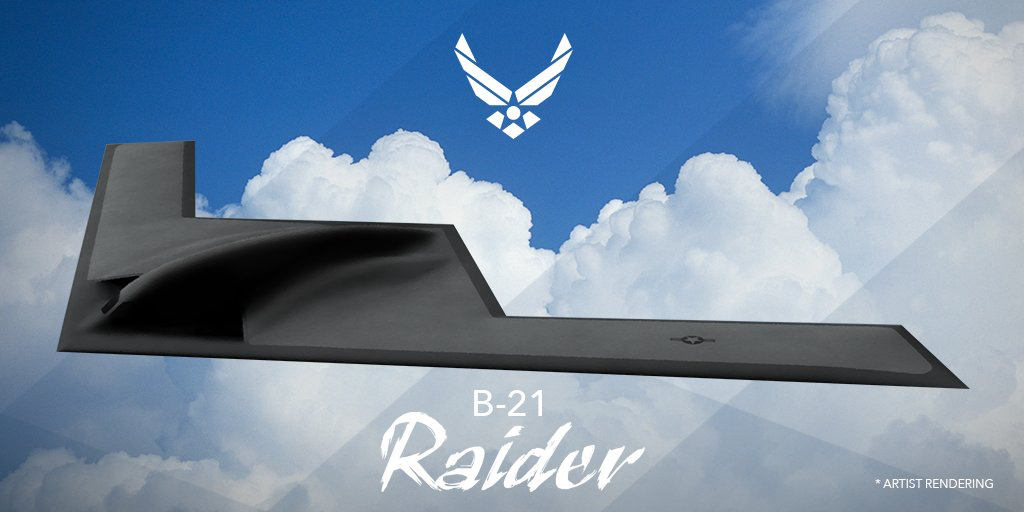
The Air Force wants more than 100 B-21 bombers and officials say all will be nuclear-capable. That would violate the force level of “up to 60 deployed heavy bombers” planned under New START.
If that were the case, then it would raise questions about US long-term nuclear forces plans, challenge nuclear arms control, and potentially influence strategic stability. Assuming delivery of about seven B-21s per year starting in 2025 and the first nuclear-capable aircraft two years later, the US would by 2028 begin to exceed the “up to 60 deployed heavy bombers” pledged in 2010 and reaffirmed in April 2014, unless it begins to denuclearize B-52 and B-2 bombers as the B-21 enters the force. Although that would be two years after a possible extended treaty had expired in 2026 leaving the United States free of legal constraints, the Pentagon currently uses the New START force level as long-term guidance for the force structure. So a decision to go beyond “up to 60 deployed heavy bombers” would be a significant change.
To avoid exceeding the “up to 60 deployed heavy bombers” force level, it would be necessary to begin reducing the number of B-52s in the nuclear mission pretty much as soon as the B-21 begins to enter the force. By the mid-2030s, all the B-52s would have to be out of the nuclear mission, and the B-2 would have to begin withdrawing from the nuclear mission as well. By 2037, there would only be room for B-21s in the “up to 60 deployed heavy bombers” force level. Any B-21 produced after that year would have to be conventional-only (see graph below). A slower B-21 production would obviously affect this projection.
How the nuclear bomber force structure evolves also has implications for development and deployment of the new nuclear air-launched cruise missile (LRSO). The Air Force has previously stated that the LRSO would be made compatible with all three nuclear bombers: B-2, B-21, and B-52. In testimony before the U.S. Congress in July 2016, Air Force Global Strike Command listed all three bombers as part of the LRSO program, but in its June 2017 testimony the command only said the LRSO “will be compatible with B-52 and B-21 platforms.” Apparently, the B-2 has been removed from the LRSO program. [Update 7/26/2017: Although AFGSC chief Gen Rand omitted the B-2 from his 2017 congressional testimonies, AFGSC PA told me the “LRSO will be compatible with B-2, B-52, and B-21″ but also reminded that the Trump administration’s NPR “will guide modernization efforts, including the future of our bombers.”]
But the B-52 is still intended to be made compatible with the LRSO. By the time the new missile becomes operation in 2030, however, half of the B-52s that are currently nuclear-capable might already have been denuclearized to make room for the B-21 under the “up to 60 deployed heavy bombers” force level (see above). The remaining nuclear B-52s would be gone from the force only a few years later, which appears to make the fielding of the LRSO on the B-52 a waste of money and effort.
The Air Force should clarify its plans for the bomber force, whether it intends to keep the “up to 60 deployed heavy bombers” force structure, how many B-21s will be nuclear-capable, and whether the LRSO needs to be made compatible with the B-52 at all.
This publication was made possible by a grant from the Carnegie Corporation of New York, the New Land Foundation, and the Ploughshares Fund. The statements made and views expressed are solely the responsibility of the author.
Monitoring Nuclear Testing is Getting Easier
The ability to detect a clandestine nuclear explosion in order to verify a ban on nuclear testing and to detect violations has improved dramatically in the past two decades.
There have been “technological and scientific revolutions in the fields of seismology, acoustics, and radionuclide sciences as they relate to nuclear explosion monitoring,” according to a new report published by Los Alamos National Laboratory that describes those developments.
“This document… reviews the accessible literature for four research areas: source physics (understanding signal generation), signal propagation (accounting for changes through physical media), sensors (recording the signals), and signal analysis (processing the signal).”
A “signal” here is a detectable, intelligible change in the seismic, acoustic, radiological or other environment that is attributable to a nuclear explosion.
The new Los Alamos report “is intended to help sustain the international conversation regarding the [Comprehensive Test Ban Treaty] and nuclear explosive testing moratoria while simultaneously acknowledging and celebrating research to date.”
“The primary audience for this document is the next generation of research scientists that will further improve nuclear explosion monitoring, and others interested in understanding the technical literature related to the nuclear explosion monitoring mission.”
See Trends in Nuclear Explosion Monitoring Research & Development — A Physics Perspective, Los Alamos National Laboratory, LA-UR-17-21274, June 2017.
“A ban on all nuclear tests is the oldest item on the nuclear arms control agenda,” the Congressional Research Service noted last year. “Three treaties that entered into force between 1963 and 1990 limit, but do not ban, such tests. In 1996, the United Nations General Assembly adopted the Comprehensive Nuclear-Test-Ban Treaty (CTBT), which would ban all nuclear explosions. In 1997, President Clinton sent the CTBT to the Senate, which rejected it in October 1999.”
New START 2017: Russia Decreasing, US Increasing Deployed Warheads
By Hans M. Kristensen
The latest set of New START aggregate data released by the US State Department shows that Russia is decreasing its number of deployed strategic warheads while the United States is increasing the number of warheads it deploys on its strategic forces.
The Russian reduction, which was counted as of March 1, 2017, is a welcoming development following its near-continuous increase of deployed strategic warheads compared with 2013. Bus as I previously concluded, the increase was a fluctuation caused by introduction of new launchers, particularly the Borei-class SSBN.
The US increase, similarly, does not represent a buildup – a mischaracterization used by some to describe the earlier Russian increase – but a fluctuation caused by the force loading on the Ohio-class SSBNs.
Strategic Warheads
The data shows that Russia as of March 1, 2017 deployed 1,765 strategic warheads, down by 31 warheads compared with October 2016. That means Russia is counted as deploying 228 strategic warheads more than when New START went into force in February 2011. It will have to offload an additional 215 warheads before February 2018 to meet the treaty limit. That will not be a problem.
The number of Russian warheads counted by the New START treaty is only a small portion of its total inventory of warheads. We estimate that Russia has a military stockpile of 4,300 warheads with more retired warheads in reserve for a total inventory of 7,000 warheads.
The United States was counted as deploying 1,411 strategic warheads as of March 1, 2017, an increase of 44 warheads compared with the 1,367 strategic deployed warheads counted in October 2016. The United States is currently below the treaty limit and can add another 139 warheads before the treaty enters into effect in February 2018.
The number of US warheads counted by the New START treaty is only a small portion of its total inventory of warheads. We estimate that the United States has a military stockpile of 4,000 warheads with more retired warheads in reserve for a total inventory of 6,800 warheads.
Strategic Launchers
The New START data shows that Russia as of March 1, 2017 deployed 523 strategic launchers, an increase of 15 launchers compared with October 2016. That means Russia has two (2) more launched deployed today than when New START entered into force in February 2011.
Russia could hypothetically increase its force structure by another 177 launchers over the next ten months and still be in compliance with New START. But its current nuclear modernization program is not capable of doing so.
Under the treaty, Russia is allowed to have a total of 800 deployed and non-deployed strategic launchers. The data shows that it currently has 816, only 16 above the treaty limit. That means Russia overall has scrapped 49 total launchers (deployed and non-deployed) since New START was signed in February 2011.
The United States is counted as deploying 673 strategic launchers as of March 1, 2017, a decrease of eight (8) launchers compared with October 2016. That means the United States has reduced its force structure by 209 deployed strategic launchers since February 2011.
The US reduction has been achieved by stripping essentially all excess bombers of nuclear equipment, reducing the ICBM force to roughly 400, and making significant progress on reducing the number of launch tubes on each SSBN from 24 to 20.
The United States is below the limit for strategic launchers and could hypothetically add another 27 launchers, a capability it currently has. Overall, the United States has scrapped 304 total launchers (deployed and non-deployed) since the treaty entered into force in February 2011, most of which were so-called phantom launchers that were retired but still contained equipment that made them accountable under the treaty.
The United States currently is counted as having 820 deployed and non-deployed strategic launchers. It will need to destroy another 20 to be in compliance with New START by February 2018.
Conclusions and Outlook
Both Russia and the United States are on track to meet the limits of the New START treaty by February 2018. The latest aggregate data shows that Russia is again reducing its deployed strategic warheads and both countries are already below the treaty’s limit for deployed strategic launchers.
In a notorious phone call between Russian President Vladimir Putin and US President Donald Trump, the Russian president reportedly raised the possibility of extending the New START treaty by another five years beyond 2021. But Trump apparently brushed aside the offer saying New START was a bad deal. After the call, Trump said the United States had “fallen behind on nuclear weapons capacity.”
In reality, the United States has not fallen behind but has 150 strategic launchers more than Russia. The New START treaty is not a “bad deal” but an essential tool to provide transparency of strategic nuclear forces and keeping a lid on the size of the arsenals. Russia and the United States should move forward without hesitation to extend the treaty by another five years.
Additional resources:
- New START Aggregate Data (as of March 1, 2017)
- Status of World Nuclear Forces
This publication was made possible by a grant from the New Land Foundation and Ploughshares Fund. The statements made and views expressed are solely the responsibility of the author.
In Reuters Interview President Trump Flunks Nuclear 101
President Donald Trump in an interview with Reuters today demonstrated an astounding lack of knowledge about basic nuclear weapons issues.
According to Reuters Trump said he wanted to build up the US nuclear arsenal to ensure it is at the “top of the pack.” He said the United States has “fallen behind on nuclear weapons capacity.”
Building up the US nuclear arsenal would be an unnecessary, unaffordable, and counterproductive move. It is unnecessary because the US military already has more nuclear weapons than it needs to meet US national and international security commitments. It would be unaffordable because the Pentagon will have problems paying for the nuclear modernization program initiated by the Obama administration. And it is counterproductive because it would further fuel nuclear buildups in other nuclear weapon states.
The claim that the US has “fallen behind on its nuclear weapons capacity” is also wrong; the US has the nuclear weapons capability it needs to meet its national and international security commitments. All nuclear-armed states have different nuclear weapons capacities depending on their individual needs. Nuclear planning is not a race but a strategy.
In terms of capacity, the United States is already at the “top of the pack” with highly capable nuclear forces that are backed up by overwhelming conventional forces. See here how the US nuclear arsenal compares with other nuclear-armed states.
Trump also called the New START Treaty “a one-sided deal” and a “bad deal.” Once again he is wrong. The treaty has equal limits for both the United States and Russia: by February 2018, neither side can have more than 1,550 warheads on 700 deployed launchers and no more than 800 total deployed and non-deployed launchers.
Next month the new bi-annual aggregate data set will be published; the previous one from September 2016 showed Russia with 1,796 warheads on 508 launchers compared with the United States with 1,367 warheads on 681 launchers.
Some people got very excited about that saying the larger number of Russian deployed warheads somehow gave Russia an advantage and showed they didn’t intend to comply with the treaty. Warheads can be moved on and off launchers relatively quickly; the important number is the number of launchers where the US was counted with 173 more than Russia.
Indeed, according to the Pentagon and Intelligence Community, Russia “would not be able to achieve a militarily significant advantage by any plausible expansion of its strategic nuclear forces, even in a cheating or breakout scenario under the New START Treaty…” (Emphasis added.)
But nitpicking about numbers misses the bigger point: the New START treaty was signed with overwhelming support from the US military, Congress, former officials, and experts because the treaty caps the nuclear forces of both countries and continues an important on-site verification system and data exchange.
President Trump may have been briefed by the Pentagon on his role in the nuclear war plan. But his latest interview with Reuters shows that he urgently needs to be briefed on the status of US nuclear forces, other nuclear-armed states, and the basics of the arms control treaties the United States has signed. But that briefing needs to be done outside the White House bubble and include bi-partisan and independent input. Otherwise all indication are that President Trump will be extraordinarily poorly equipped to make informed decisions about the nuclear policy.
Additional resources:
This publication was made possible by a grant from Carnegie Corporation of New York and Ploughshares Fund. The statements made and views expressed are solely the responsibility of the author.
In Reuters Interview President Trump Flunks Nuclear 101
President Donald Trump in an interview with Reuters today demonstrated an astounding lack of knowledge about basic nuclear weapons issues.
According to Reuters Trump said he wanted to build up the US nuclear arsenal to ensure it is at the “top of the pack.” He said the United States has “fallen behind on nuclear weapons capacity.”
Building up the US nuclear arsenal would be an unnecessary, unaffordable, and counterproductive move. It is unnecessary because the US military already has more nuclear weapons than it needs to meet US national and international security commitments. It would be unaffordable because the Pentagon will have problems paying for the nuclear modernization program initiated by the Obama administration. And it is counterproductive because it would further fuel nuclear buildups in other nuclear weapon states.
The claim that the US has “fallen behind on its nuclear weapons capacity” is also wrong; the US has the nuclear weapons capability it needs to meet its national and international security commitments. All nuclear-armed states have different nuclear weapons capacities depending on their individual needs. Nuclear planning is not a race but a strategy.
In terms of capacity, the United States is already at the “top of the pack” with highly capable nuclear forces that are backed up by overwhelming conventional forces. See here how the US nuclear arsenal compares with other nuclear-armed states.
Trump also called the New START Treaty “a one-sided deal” and a “bad deal.” Once again he is wrong. The treaty has equal limits for both the United States and Russia: by February 2018, neither side can have more than 1,550 warheads on 700 deployed launchers and no more than 800 total deployed and non-deployed launchers.
Next month the new bi-annual aggregate data set will be published; the previous one from September 2016 showed Russia with 1,796 warheads on 508 launchers compared with the United States with 1,367 warheads on 681 launchers.
Some people got very excited about that saying the larger number of Russian deployed warheads somehow gave Russia an advantage and showed they didn’t intend to comply with the treaty. Warheads can be moved on and off launchers relatively quickly; the important number is the number of launchers where the US was counted with 173 more than Russia.
Indeed, according to the Pentagon and Intelligence Community, Russia “would not be able to achieve a militarily significant advantage by any plausible expansion of its strategic nuclear forces, even in a cheating or breakout scenario under the New START Treaty…” (Emphasis added.)
But nitpicking about numbers misses the bigger point: the New START treaty was signed with overwhelming support from the US military, Congress, former officials, and experts because the treaty caps the nuclear forces of both countries and continues an important on-site verification system and data exchange.
President Trump may have been briefed by the Pentagon on his role in the nuclear war plan. But his latest interview with Reuters shows that he urgently needs to be briefed on the status of US nuclear forces, other nuclear-armed states, and the basics of the arms control treaties the United States has signed. But that briefing needs to be done outside the White House bubble and include bi-partisan and independent input. Otherwise all indication are that President Trump will be extraordinarily poorly equipped to make informed decisions about the nuclear policy.
Additional resources:
This publication was made possible by a grant from Carnegie Corporation of New York and Ploughshares Fund. The statements made and views expressed are solely the responsibility of the author.
Two Views of the Open Skies Treaty
Russian surveillance of military facilities under the Open Skies Treaty is problematic for the security of U.S. nuclear forces, a U.S. Air Force general told Congress last year. No, it is not, a U.S. Navy admiral said.
Those two disparate views were offered in response to a question for the record from Rep. Mike Coffman (R-CO) following a hearing of the House Armed Services Committee last year.
“Several Defense officials have expressed concerns about Russia’s intent to use advanced digital sensors to collect imagery under the Open Skies Treaty,” Rep. Coffman said. “Is this a significant concern for our nuclear forces?”
“Intelligence collection against our nuclear forces is always a concern,” replied Gen. Robin Rand, commander of the U.S. Air Force Global Strike Command.
“The imaging system to be placed on the Tu-214 and Tu-154 is already in use on Russian aircraft flying Open Skies missions over Europe. The new system possesses greater range and an advanced digital processing capability, providing a significant increase in the number of images that can be collected. This digital capability, through post mission image refinement of raw image data, could potentially enable the Russians to violate the treaty by keeping the raw image data and later using advanced digital image enhancement techniques to refine resolution beyond that allowed in the treaty,” Gen. Rand wrote (at p. 105).
But the same question from Rep. Coffman about the potential threat from improved Russian sensors elicited a substantially different response from VADM Terry Benedict, director of Navy Strategic Systems Programs.
“I do not believe this is a significant concern to our nuclear forces. The resolution of Open Skies imagery is similar to that available in commercial satellite imagery,” VADM Benedict wrote (at p. 106).
Moreover, he added, “All State Parties have the right under the Treaty to certify new sensors and aircraft. The United States and several of our Allies are in various stages of acquiring new digital sensors. The information Russia gleans from Open Skies is of only incremental value in addition to Russia’s other means of intelligence gathering.”
The two responses serve to illustrate the inconvenient reality that many questions of national security policy do not have simple, unequivocal answers. Views that would seem to be authoritative may be contradicted by other assessments that are equally authoritative. Reconciling the contradiction, or overcoming it, requires further investigation. And even that may not be sufficient.
Rep. Coffman’s exchange with Gen. Rand and VADM Benedict appeared in a hearing volume published last month on Fiscal Year 2017 Budget Request for Department of Defense Nuclear Forces, March 2, 2016, which also contains material of interest on nuclear weapons modernization programs, projected costs, and other policy matters.
Related issues were also discussed in another House Armed Services Committee hearing volume that was published last month. See U.S. Strategic Forces Posture, February 24, 2016.
Obama Administration Announces Unilateral Nuclear Weapon Cuts
By Hans M. Kristensen
The Obama administration has unilaterally cut the number of nuclear weapons in the Pentagon’s nuclear weapons stockpile to 4,018 warheads, a reduction of 553 warheads since September 2015.
The reduction was disclosed by Vice President Joe Biden during a speech at the Carnegie Endowment for International Peace earlier today.
This means that the Obama administration during its two terms has reduced the US nuclear weapons stockpile by 1,255 weapons compared with the size at the end of the George W. Bush administration – a number greater than the estimated number of warheads in the arsenals of Britain, China, France, India, Israel, North Korea, and Pakistan combined.
Stockpile Reductions In Context
The Obama administration’s additional unilateral cut shows up as a small dip on the graph of US nuclear weapons stockpile changes since 1945 (see figure below; graph corrected Sep 2017).
Even so, the Obama administration still holds the position of being the administration that has cut the least warheads from the stockpile compared with other post-Cold War presidencies.
Part of the reason for this is that the overall size of the stockpile today is much smaller than two decades ago, so one would expect new warhead cuts to also be smaller. But this is only partially true because the George W. Bush administration cut significantly more warheads from the stockpile than the Clinton administration.
In fact, it is still the case that Republican presidents in the post-Cold War period have cut many more warheads from the stockpile than have Democratic presidents: 14,801 versus 4,437.
Even so, the latest cut means that the Obama administration has managed to surpass (barely) the Clinton administration in terms of how much it reduced the stockpile (24 percent versus 23 percent) (see figure below).
Reducing the Hedge
The administration has not disclosed what types of warheads were cut from the stockpile or what part of it they were taken from. We estimate that the warheads were taken from the inactive reserve of non-deployed warheads that are stored to provide a “hedge” against technical failure of a warhead type or to respond to geopolitical surprises.
The 2013 Nuclear Employment Strategy determined that the hedge was too big and that it was only necessary to hedge against technical warhead failure. That hedge would also serve as a geopolitical hedge. As a result, several hundred hedge warheads were no longer needed.
So the 553 cut warheads probably include excess W76, B61, and B83 warheads that were scheduled to be retired anyway as a result of changes to the nuclear war plans and the ongoing warhead life-extension programs. [Update 011317: In addition to excess W76s, the cut might also include the W84 warhead that previously armed the Ground Launch Cruise Missile. The W84 was retired once but brought back into the stockpile as a potential warhead candidate for the LRSO. But after the W80 was selected as the LRSO warhead, the W84 might have met its doom (House conservatives tried to prohibit dismantlement of the W84 in the FY2017 defense bill but the effort didn’t survive the final cut). Yet there were fewer than 400 W84s produced, so the 553 cut (“almost 500 warheads for dismantlement on top of those previously scheduled for retirement”) would have to include other warhead types as well. Those could potentially also include excess W78 ICBM warheads. Any potential B61s would likely be minimal because they await production of the B61-12.]
The Growing Dismantlement Queue
The cut adds significantly to the large inventory of retired (but still intact) warheads that are awaiting dismantlement. Secretary of State John Kerry announced in April 2015 that the retirement queue included some 2,500 warheads. Vice President Biden announced that the number has since grown to about 2,800 warheads.
Biden also announced that the Obama administration during its eight years in office had dismantled 2,226 warheads. That indicates that about 250 warheads were dismantled in the last year.
The administration has promised that all the warheads that were retired prior to 2009 will be dismantled by 2021 (in reality some warheads already dismantled were retired after 2009). But with the average rate of about 278 warheads dismantled per year during the Obama administration, it will take until 2026 to dismantle the current backlog of retired warheads.
Political and Strategic Implications
The Obama administration must be congratulated on taking additional steps to unilaterally reduce the US nuclear weapons stockpile and improve its nuclear arms reduction legacy.
This will help the US position at the Preparatory Conference for the nuclear Non-Proliferation Treaty (NPT) later this spring and will increase pressure on the other nuclear-weapons states party to the treaty (Russia, China, France, and Britain) to also take new initiatives – even without formal arms negotiations.
The Obama administration also deserves praise for continuing to provide transparency of the US nuclear arsenal. Not only has it disclosed the history of the US nuclear stockpile and provided annual updates. It has also disclosed its warhead dismantlement history and declared how many retired warheads remain in the dismantlement queue. And it has declassified other chapters of the US nuclear history, including the number of nuclear weapons deployed at sea during the Cold War.
This transparency helps facilitate a debate about the history and future of nuclear weapons that is based on facts rather than rumors. Moreover, it helps increase the incentive for other nuclear-armed states to also be more transparent. If Britain and France were also to disclose their nuclear stockpile and dismantlement histories, the three Western nuclear powers would have a significantly stronger position from which to urge Russia and other nuclear-armed states to be more transparent about their arsenals.
At home, the Obama administration’s announcement about the additional nuclear cuts helps shine the light on the Trump administration and what its nuclear policies will be. Some will decry the Obama administration’s unilateral cut as weakening US military strength, but that would be wrong for several reasons.
First, the Obama administration has started a nuclear weapons modernization program that makes the George W. Bush administration pale in comparison.
Second, the cut reflects US military requirements. The Pentagon has long stated that even after the New START treaty is implemented next year, the United States will still have up to one-third more nuclear warheads deployed than is needed to meet US national and international commitments.
Russia currently has a nuclear weapons stockpile of nearly 4,500 warheads but is also reducing its nuclear arsenal (despite a temporary increase in deployed warheads counted under New START). While some commentators are obsessed with US-Russian nuclear parity, the Pentagon seems less interested in numbers and more interested in quality and in 2012 concluded:
The “Russian Federation…would not be able to achieve a militarily significant advantage by any plausible expansion of its strategic nuclear forces, even in a cheating or breakout scenario under the New START Treaty, primarily because of the inherent survivability of the planned U.S. Strategic force structure, particularly the OHIO-class ballistic missile submarines, a number of which are at sea at any given time.”
Instead, the Trump administration should continue the broad outline of the Obama administration’s nuclear policy of gradually but responsibly reducing the numbers and reliance on nuclear weapons while actively seeking to persuade other nuclear-armed states to follow the example.
Additional Information:
- United States nuclear forces, 2017 [Note: this publication was researched before the 2017 stockpile announcement.]
- Global Overview: Status of World Nuclear Forces
This publication was made possible by a grant from the New Land Foundation and Ploughshares Fund. The statements made and views expressed are solely the responsibility of the author.
Jeremy J. Stone, 1935-2017
Jeremy J. Stone, a pioneering arms control advocate who served as president of the Federation of American Scientists (FAS) from 1970 to 2000, passed away on January 1, 2017 at his home in Carlsbad, California.
A mathematician by training, he turned to nuclear arms control in the early 1960s with a focus on preventing the development and deployment of anti-ballistic missile (ABM) systems due to their destabilizing potential. The Anti-Ballistic Missile Treaty, signed by the US and the USSR in 1972, was shaped in large part by Jeremy and his scientific colleagues, who collectively created the foundation for nuclear arms control in the last decades of the Cold War.
Jeremy jump-started the process of scientific exchange with China in the early 1970s. He was a prominent defender of dissident Soviet scientist Andrei Sakharov, and he instituted new mechanisms for monitoring and upholding the human rights of scientists around the globe. He discovered and helped terminate a CIA program to open U.S. mail.
All of these episodes, and many more, were vividly and insightfully described in his 1999 memoir “Every Man Should Try: Adventures of a Public Interest Activist”.
Jeremy was a chess-player, on and off the chess board. He took a strategic approach to his work and his life. He did not drift. He was always on his way towards one goal or another. He might take you with him if you were lucky.
He was a scintillating conversationalist who could successfully engage even the most tongue-tied staffer or physicist. He had a sophisticated sense of humor which he wielded skillfully — perhaps following the example of his early Hudson Institute boss, the nuclear strategist Herman Kahn — to disarm opponents and to make his own ideas more palatable to skeptical or hostile audiences.
He was lucky in love, having been married for 58 years to BJ (Yannet) Stone, a brilliant, beautiful and kind mathematician, who passed away in 2015.
He was an exceptionally capable talent-spotter, and he could see the latent potential in people that they could scarcely imagine in themselves. At the Federation of American Scientists, he gathered a group of scruffy young individuals of no particular academic pedigree or obvious distinction and he shined his peculiar light on them until they bloomed. He presented them (us) with enormously difficult problems — ballistic missile defense, nuclear proliferation, global arms sales, government secrecy — and challenged them to tackle those problems in creative new ways.
Of course, he was not without flaws. His intuitive powers, which usually made him uncommonly perceptive, occasionally hardened prematurely into convictions that proved to be unfounded. In one particularly lamentable episode, he suggested mistakenly that MIT physicist Philip Morrison, a Manhattan Project veteran and FAS founder, had once spied for the Soviet Union. Making such a false allegation could have been an unforgivable offense. But Morrison, himself a person of awesome depth and distinction, forgave him, although with some sadness.
More typically, Jeremy was a profoundly generous and thoughtful person. His intelligence and problem-solving abilities were often directed to meeting the needs of others — not just friends or employees (he once directed poorly dressed staff to buy some new clothes at his expense), but also casual acquaintances, foreigners, children and strangers. He knew how to give a gift, and he usually anticipated exactly what gift a particular person wanted or needed.
Above all, Jeremy was an institution builder, turning the Federation of American Scientists into a public interest platform of significant influence.
“FAS is a legitimate and prestigious scientific association,” wrote Secretary of State Henry Kissinger in a classified cable to the US Embassy in Japan in 1975. “Dr. Stone… is [a] highly regarded lobbyist on foreign policy and has wide contacts on the Hill. Embassy should have no reservations about facilitating his appointments in Japan,” Kissinger wrote.
By the time I showed up at FAS in 1989, the organization under Jeremy’s leadership had become a powerhouse of intelligent and effective advocacy in arms control and quite a few other areas. My own cohort included figures like John Pike, David Albright, Lora Lumpe, and the late Tom Longstreth, to name just a few. Wandering the halls of our Capitol Hill headquarters, I would sometimes run into Carl Sagan, former CIA director Bill Colby, Philip Morrison, Paul Nitze, former JFK aide Carl Kaysen, Ted Taylor, Dick Garwin, former Senator Alan Cranston, and you could never be sure who else. One day I literally collided with Hans Bethe in the hallway outside Jeremy’s office. (No particles were emitted.) Jeremy made all of that possible, providing a forum for scientists and others to participate in the national policy process and a strategic vision to guide them.
After leaving FAS, Jeremy pursued further adventures in conflict resolution as president of Catalytic Diplomacy, created a website in honor of his father, I.F. Stone, and advocated for independent journalism.
Will Trump Be Another Republican Nuclear Weapons Disarmer?
By Hans M. Kristensen
Republicans love nuclear weapons reductions, as long as they’re not proposed by a Democratic president.
That is the lesson from decades of US nuclear weapons and arms control management.
If that trend continues, then we can expect the new Donald Trump administration to reduce the US nuclear weapons arsenal more than the Obama administration did.
What? I know, it sounds strange but the record is very clear: During the post-Cold War era, Republication administrations have – by far – reduced the US nuclear weapons stockpile more than Democratic administrations (see graph below).
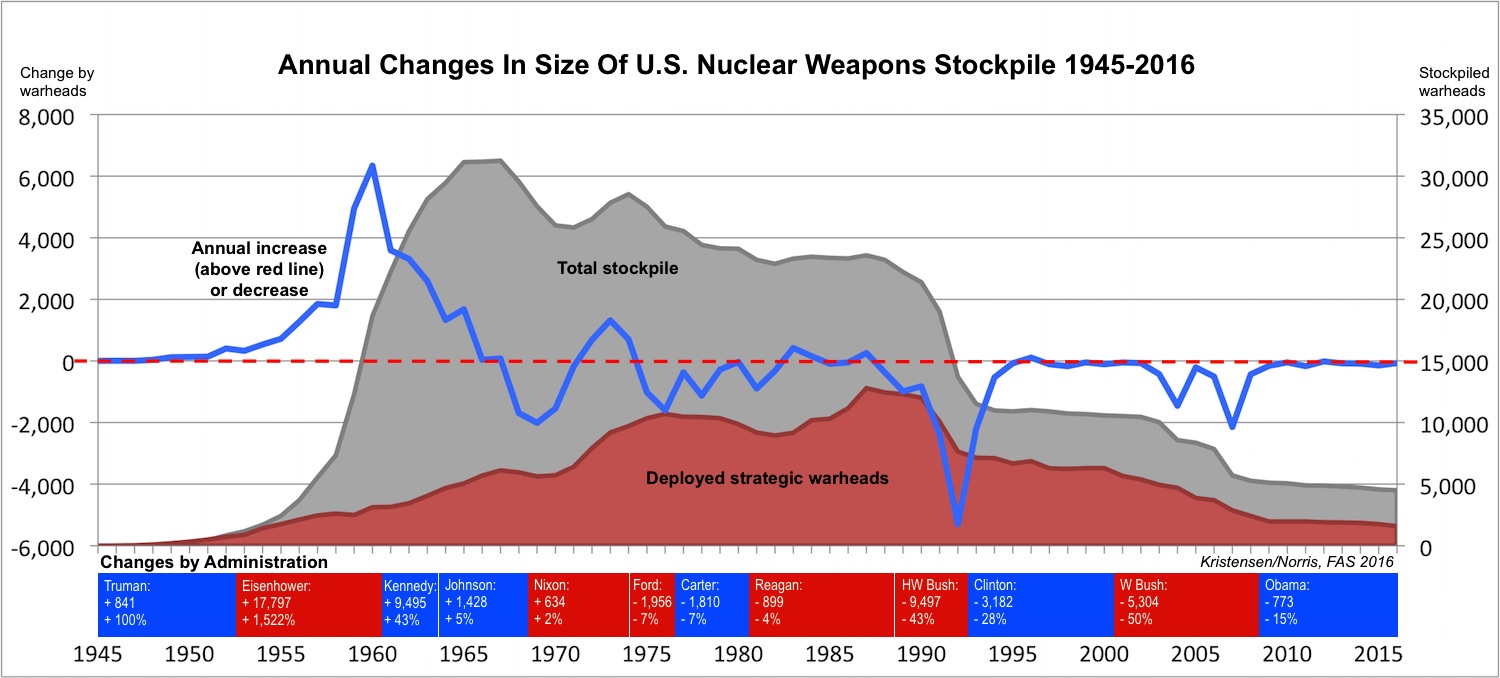
Even if we don’t count numbers of weapons (because arsenals have gotten smaller) but only look at by how much the nuclear stockpile was reduced, the history is clear: Republican presidents disarm more than Democrats (see graph below).
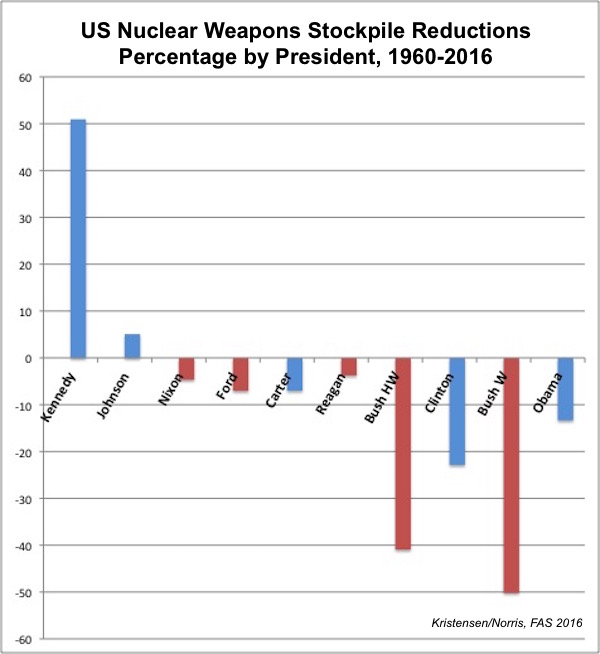
It’s somewhat of a mystery. Because Democratic presidents are generally seen to be more likely to propose nuclear weapons reductions. President Obama did so repeatedly. But when Democratic presidents have proposed reductions, the Republican opposition has normally objected forcefully. Yet Republican lawmakers won’t oppose reductions if they are proporsed by a Republican president.
Conversely, Democratic lawmakers will not opposed Republican reductions and nor will they oppose reductions proposed by a Democratic president.
As a result, if the Republicans control both the White House and Congress, as they do now after the 2016 election, the chance of significant reductions of nuclear weapons seems more likely.
Whether Donald Trump will continue the Republication tradition remains to be seen. US-Russian relations are different today than when the Bush administrations did their reductions. But both countries have far more nuclear weapons than they need for national security. And Trump would be strangely out of tune with long-held Republican policy and practice if he does not order a substantial reduction of the US nuclear weapons stockpile.
Perhaps he should use that legacy to try to reach an agreement with Russia to continue to reduce US and Russia nuclear arsenals to the benefit of both countries.
Further reading: Status of World Nuclear Forces
This publication was made possible by a grant from the New Land Foundation and Ploughshares Fund. The statements made and views expressed are solely the responsibility of the author.
Human Factors in Verifying Warhead Dismantlement
Arms control agreements that envision the verified dismantlement of nuclear weapons require the availability of suitable technology to perform the verification. But they also depend on the good faith of the participants and a shared sense of confidence in the integrity of the verification process.
An exercise in demonstrated warhead dismantlement showed that such confidence could be easily disrupted. The exercise, sponsored by the United States and the United Kingdom in 2010 and 2011, was described in a recent paper by Los Alamos scientists. See Review of the U.S.-U.K. Warhead Monitored Dismantlement Exercise by Danielle Kristin Hauck and Iain Russell, Los Alamos National Laboratory, August 4, 2016.
Participants played the roles of the host nation, whose weapons were to be dismantled, and of the monitoring nation, whose representatives were there to verify dismantlement. Confusion and friction soon developed because “the host and monitoring parties had different expectations,” the authors reported.
“The monitoring party did not expect to justify its reasons for performing certain authentication tasks or to justify its rationale for recommending whether a piece of equipment should or should not be used in the monitoring regime. However, the host party expected to have an equal stake in authentication activities, in part because improperly handled authentication activities could result in wrongful non-verification of the treaty.”
“Attempts by the host team to be involved in the authentication activities, and requests for justifications of monitoring party decisions felt intrusive and controlling. Monitoring party rebuffs to the host team reduced the host’s confidence in the sincerity of the monitoring party for cooperative monitoring.”
What emerged is that verified dismantlement of nuclear weapons is not simply a technical problem, though it is also that.
